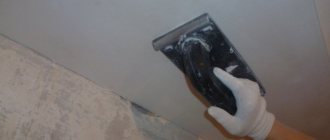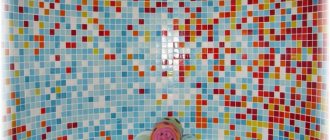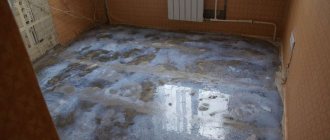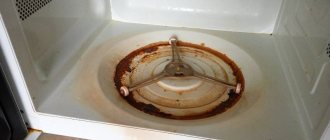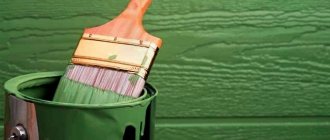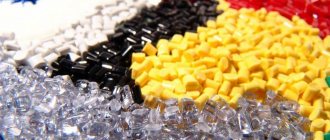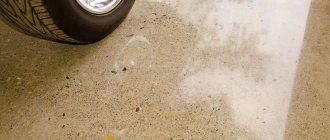Enamels for floors and stairs in Moscow
In order for floors and stairs to have an aesthetic appearance, and their surface to be reliably protected from moisture, aggressive chemicals and mechanical damage, it is recommended to coat them with special enamels. This applies to both those structures that are made of wood and those for the construction of which cement-sand mixtures were used. High-quality enamels for floors and stairs produced by leading domestic and foreign companies can be purchased in the online store and retail stores of the Leroy Merlin network.
We offer a wide range of:
- Alkyd enamels for floors and stairs;
- Acrylic enamels for floors and stairs;
- Polyurethane enamels for floors and stairs.
Each type of these coatings has its own characteristics, advantages and its own scope of application. Alkyd enamels are made on the basis of glypthal or pentaphthalic varnish. Their advantages include water resistance, elasticity and durability of coatings, and almost complete absence of shrinkage. In addition, alkyd enamels for floors and stairs perfectly withstand significant temperature changes and retain their original color for a long time. They are suitable for painting floors and stairs in any room.
Acrylic enamels are water-based, do not contain any volatile or harmful substances, have excellent moisture resistance, are highly resistant to wear, and dry quickly after application. They can be used to paint both wood and concrete floors indoors.
Enamels for floors and stairs on a semi-urethane basis are distinguished by excellent adhesion to any surface, are very resistant to acids and alkalis, and form a film that perfectly resists mechanical damage. Most often they are used to cover surfaces experiencing increased load. It is rarely used in residential buildings due to its relatively high cost.
Types of paints
Oil base
The traditional type of coating with these compounds requires a long time to dry. Therefore, preference is increasingly being given to quick-drying enamels without odor and allergic effects from their components. If you use a solvent that evaporates well for oil paint, the time it takes to completely harden will be reduced.
Acrylic enamel
It is moisture resistant, elastic and has a safety margin against wear. The enamel base is natural acrylic resin. The binding component is water. After it evaporates from the surface, the composition hardens.
Alkyd enamel
It is based on natural resins. Its quality is close to acrylic enamel. Alkyd resins are paint components that harden after the binder components evaporate. It becomes wear-resistant and fade-resistant.
Latex paint
This type belongs to the category of the most expensive coatings. Latex is the sap of the rubber plant. The compositions in paint are a dispersion of rubber polymers. In order to make products accessible to most buyers, artificial substitutes are added to them, which makes them cheaper. Fillers of natural origin have a multifaceted range of colors. Latex paint is given another name - “rubber”, because of the rubber it contains. This property helps to cover defects and microcracks on the base of the floor. In terms of its technical parameters, it differs from all others in quality and price.
Polyurethane
This odorless floor paint has long-lasting color. It does not fade from exposure to ultraviolet radiation. When applying it, you can create the effect of a pressed lye. The special difference between this paint and others is that it can be used to cover concrete bases or paving slabs . The packaging should include an explanation for which floors the paint can be used. To do this, the containers indicate which substrates can be covered with it. Concrete and wood have different chemical compositions. Before applying polyurethane paint, the floor must be primed.
For concrete floors
For this type of coating, enamel with an alkyd-urethane component, a special composition of polymers and organosilicate is used. In addition to them, you can use rubber paint with latex, since it contains a filler in the form of rubber.
Are there “universal” paints with the same surface drying time?
The answer is clear - no. Universality is just a myth used by unscrupulous manufacturers solely for advertising purposes. At best, you buy paint with a one-time or very short-term effect. Therefore, you should not believe the manufacturer’s promises that the paint is equally ideal for repairing the paint surface of a car, for heating radiators, and for decorating a kitchen or bedroom. An excellent result will only be achieved if the paint is used for a specific purpose. In other cases, you will get a mediocre result and simply throw money away.
Often, when choosing, the decisive question is how long the paint takes to dry. This is objectively and directly related to its composition and the environmental conditions in which drying should occur. Why is it important? The pace of paint and varnish work has a direct impact on the overall speed of repair. For example, it is not recommended to carry out any other finishing work while the paint is drying. Otherwise, dust and other construction debris will simply stick to the painted surface.
Don't complain about the weather, do something
Depending on the weather, you can choose a different finishing method or change the properties of the finishing composition. For example, in hot weather, you can thin the composition with an appropriate solvent or thinner to increase drying time and avoid brush marks. However, this will require more layers of coating to create the required film thickness and achieve the desired gloss level. In addition, the longer the coating takes to dry, the more dust will settle on its wet and sticky surface.
In order to significantly speed up the finishing process during the cold season (for example, you are in a hurry to finish the job with New Year's gifts that need to be completely dried, packaged and the Christmas tree laid out in one or two days), it is better to immediately choose other finishing compounds. Shellac, nitro varnish or varnish polish dries faster than other products at low temperatures. However, it is best to do finishing when it is not too cold, not too hot and not too humid. And before you dip your brush into a can or prime your paint gun, make sure the wood, the finish, and the surrounding air are at the same temperature.
MASTER'S ADVICE
Characteristics
Choosing a gas stove is a crucial step for every housewife. Women are usually concerned about how their new home appliances will look. Men are interested in the dimensions and weight of equipment. Dimensions will depend on the brand and sample of the device.
Old style
Old-style copies from different manufacturers do not differ much from each other. The dimensions of a standard Soviet stove are 55 cm wide and 65 cm deep. The average weight is 30-40 kg. The maximum figure does not reach more than 50 kg. Typically the stove has 4 gas burners and one oven compartment.
Modern representatives
Gas stoves from modern manufacturers are famous for their diversity and large selection of different variations. The most popular include:
- Tourist. They are famous for their uniqueness, as they are convenient to take on a hike or fishing. On average, their price is about 1000 - 1500 rubles, dimensions are 175x200x100 mm. This one weighs no more than 1.5 kg. The stove comes without an oven, only 1-2 burners;
- Homemade. Dimensional samples are installed in houses or apartments. They have parameters of 650x650x800 mm. Their weight reaches up to 45 kg. It depends on the material from which it is made, the number of burners and the presence/absence of an oven.
The main advantage of modern models is that they are lighter in weight, have gas control, and cast iron grates. In addition, they fit perfectly into any interior.
Owners of small kitchens should pay attention to miniature models of gas stoves. Most often they come separately from the oven and are built into the kitchen structure. On average, the weight of such a slab is 20-25 kg. Such household appliances do not differ much from large-sized options. They are equipped with the same functions and have the same number of burners (from 1 to 4).
Review of popular manufacturers
The most famous brands of floor coverings include:
- V.G.T. Easy to use and do not have an unpleasant aroma;
- Lakra. Distributed in liquid form. Small selection of colors and shades;
- Tex. The odorless substance used for most materials from which the floor is made takes a long time to dry, but is sold at an affordable price;
- Prestige. Large selection of colors, while the price is affordable for everyone.
The quick-drying, odorless paint can be used on any subfloor. It includes boards, slabs of wood chips and concrete. Such coloring compositions are varied in the components they contain, have a variety of colors, but they are all non-toxic and environmentally friendly.
Quick-drying paint occupies a large niche in the building materials market. She is in demand and in great demand. The sale of dyes of this type prevails over other materials intended for flooring, although their cost is higher. This is explained by the fact that when applied, the time for the entire cycle of finishing work is significantly reduced, and most of them are based on natural components.
Manufacturers
Several manufacturers that produce high-quality paints and varnishes, including enamels, are especially popular on the domestic building materials market:
- VGT are long-lasting products without an unpleasant odor. They are suitable even for beginners who do repairs themselves.
- "Lakra" - products with a liquid texture. The products have a small color palette. Customer reviews are mixed.
- "Tex" are universal products without a specific odor. These are long-drying compounds sold at an affordable price. They get very good reviews.
- “Prestige” – high-quality, affordable enamels, which are available in a wide range of colors. A large selection of options with a variety of effects allows even the most picky customers to make a purchase.
Enamels and nitro paints
For most of these compositions, coating with a second layer is allowed within 20-30 minutes after applying the first layer. It takes about the same time for the second layer to dry. Manufacturers allow up to 12 hours for complete hardening so that painted products can be used.
Please note that nitro-based paints dry faster than enamels. This is also due to the primary areas of use of nitro paints and enamels. The former are mostly intended for painting metal and plastic surfaces (provided that the solvent in the paint base does not “eat” the plastic). Enamels can be used to cover any surface, including wood.
For PF 115 enamel, for example, the drying time is directly related to the thickness of the layer applied during painting and the color of the paint. For example, it will take 48 hours for cherry and red enamel to dry. For everyone else, 24 hours is enough.
Terminology[ | ]
Products and semi-finished products obtained by forging are called “ forging”
" When forging in dies, the metal is confined on all sides by the walls of the die. When deformed, it takes the shape of this cavity (see Stamping, Rotary forging). With free forging
(manual and machine) metal is not limited at all or limited on one side. In hand forging, the metal or tool is directly impacted with a handbrake, sledgehammer or hammer.
Open forging is also used to improve the quality and structure of the metal. During forging, the metal is strengthened, so-called discontinuities are welded and large crystals are crushed, as a result of which the structure becomes fine-grained and acquires a fibrous structure.
performed on special equipment - hammers with a mass of falling parts from 40 to 5000 kg or hydraulic presses developing forces of 2 - 200 (200 - 20,000 tf), as well as on forging machines. They produce forgings weighing 100 tons or more. To manipulate heavy workpieces during forging, cranes with a lifting capacity of up to 350 tons, tilters and special manipulators are used.
Forging is one of the economical ways to produce blank parts. In mass and large-scale production, die forging is predominantly used, and in small-scale and individual production, free forging is used. When forging, a set of blacksmith tools is used, with the help of which the workpieces are given the required shape and size.
Acrylic paint drying time
When drying, the acrylic composition goes through certain stages, regardless of the application method. If liquid acrylic was used when painting, then it will take much longer for complete drying, since this is required by the thinners that are used.
Stage 1 – “Evaporation”
This is liquid acrylic itself, which evaporates during application to the surface. Once in the atmosphere, solvents and water leave the paint; this is the first stage of drying. For liquid formulations, this stage may take several days.
Stage 2 – “Film Formation”
After the light volatile substances evaporate, the paint begins to form a film. In those places where the acrylic is laid down thinly, the film will appear faster, and where the film is laid down in a thicker layer, its formation will take up to 8 hours.
Stage 3 – “Drying without sticking”
At the next stage of drying, you can check the dryness of the surface by applying your fingers; if the paint has dried completely, then touching it will not spoil the painting. Usually this stage occurs after 24 hours.
Stage 4 – “Deceptive State”
At this stage, it seems that the paint is completely ready for the application of the next layers, epoxy resin or varnish, but this is not entirely true. Although the paint looks dry on the outside, the inner layers are not yet fully formed and applying different compounds to them can lead to paint peeling or smearing. Typically it takes 48 hours to complete this stage.
Stage 5 – “Complete drying”
At the last stage of drying, the acrylic completely hardens. As a rule, all volatile substances and evaporators are completely evaporated at this stage and the coating is ready for the next application of varnish, additional layers of solution or epoxy. Acrylic paint may release small amounts of volatiles for several weeks. The last stage takes 72 hours.
Options
The technical characteristics of the suspension are standard for a paint product of this type and comply with GOST requirements.
Properties and description of the enamel composition
The composition of the mixture, in addition to alkyd varnish, includes:
- organic solvent;
- pigment;
- drier – an element that accelerates the drying process;
- coalescents providing film formation;
- thickeners;
- biocides, preservatives and other additives.
Advantages
The main advantage of pf 266 for flooring is the ratio between price and quality. Despite the fact that LKS is a cheap material, its quality indicators are not inferior to expensive compounds.
Pros related to floor paint PF 266:
- final result of glossy coating – 55%;
- dense covering layer;
- pf 266 is resistant to temperature fluctuations (from -10 to +40 g) and ultraviolet radiation;
- resistance to corrosion;
- high level of adhesion;
- elasticity;
- easy application, both with a paint brush and with a spray gun;
- service life 5 years;
- affordable price.
Flaws
Floor enamel PF 266 contains a solvent with a pungent odor. Therefore, when working with this material, painting is carried out only in a well-ventilated area and using protective equipment.
Also, the disadvantages of this material include:
- high degree of fire hazard;
- deformation upon contact with alkaline materials;
- limited color palette. Enamel PF 268 for the floor has only three color versions: red, yellow, golden brown.
General factors that have the same effect on the drying of any paint
Of course, the paint base has a direct impact on drying speed. But, in addition to this, you should also take into account external factors, the influence of which determines how quickly the mixture hardens:
- Surface porosity. The larger the capillary structure of the material being painted and the amount of paint that gets inside, the longer the drying time. For example, the same paint dries faster on metal than on wood. To close the pores and create an evenly homogeneous surface, various primers are used.
- The ambient temperature also affects the rate of evaporation of the components included in the paint. However, excessively high temperatures may not cause acceleration of polymerization, but, on the contrary, make the composition more liquid and, accordingly, slow down the drying rate. Manufacturers usually indicate the temperature range acceptable for applying paint.
- Ambient air humidity. Some paints and varnishes do not release moisture well in humid air, which increases the drying rate.
- Availability of ventilation. All paints dry faster with more active air movement. However, drafts are contraindicated - a more competent solution is to use a forced supply and exhaust ventilation system, balanced in volume and speed.
- Another factor is the thickness of the paint layer applied to the surface. The thicker the coating, the longer the drying process.
How to prepare a surface for painting
Whatever paint you choose, you cannot apply it to the surface without prior preparation. The presence of damage, minor defects and dust on the base increases the consumption of enamel and reduces its adhesion, which leads to delamination of the coating, the appearance of bubbles, and uneven color. Depending on the type of floor, the preparation process differs.
Concrete floor preparation
To work you will need:
- metal spatula;
- polymer or cement putty;
- grinder with grinding attachment;
- vacuum cleaner;
- roller;
- primer for concrete surface.
The floor must be carefully inspected to identify any defects. The cracks are expanded along the length, cleaned of dust, and filled with putty. Stains from oils, detergents and rust are removed using a solvent. The tubercles are removed with a grinder, and the recesses are leveled with a putty mixture. Finally, the entire surface is sanded, small particles are removed with a vacuum cleaner and a primer is applied in an even layer. For higher adhesion, it is recommended to prime in 2 layers, and the second can be applied only after the first has dried.
Preparing a Wooden Floor
Preparing a Wooden Floor
To work you will need:
- sander;
- metal spatula;
- wood primer;
- brush;
- soap solution.
The easiest way is to prepare new floors, without cracks and remnants of the old coating. Sanded, tightly laid boards are covered with a layer of primer, dried and primed again, and this is where the pre-treatment ends. If you need to paint an old floor, you should first evaluate the strength of the previous coating. If there are peelings and cracks, the old paint is completely removed with a spatula; especially difficult areas are treated with sandpaper. The cracks between the boards must be covered with floor putty, the surface is cleaned of dust, and stains are removed.
It is better to remove old paint
Removing paint using wire brushes
If the previous coating remains firmly in place, the floor should be thoroughly washed with soapy water, then rinsed with clean water and dried. Grease stains are removed with a solvent, wax residues are removed with a warm soda solution - 1 cup of soda ash per 8 liters of water.
Before painting, be sure to wash the floor with soapy water.
The completely dry floor is primed in 2-3 layers.
Composition for priming and bioprotective treatment of wood
Tips and tricks for choosing floor enamel
When choosing enamel for floor work, it is recommended to contact a consultant at the hardware store where you plan to purchase the paint, who will recommend the ideal enamel option, depending on the floor material and coating characteristics.
If the drying time of the enamel is long, this does not mean that the paint material is of poor quality; on the contrary, most often the repaired surface lasts a long time without losing its color shade. But quick-drying paints are still considered more popular; you should pay attention to reviews of this coating and buy it at trusted large construction retail outlets.
Selection of enamel in accordance with the floor material
According to the description and properties, enamel compositions are very well suited for protecting surfaces from harmful effects and damage. But the material from which the flooring is made must correspond to a certain type of paint:
- Enamel for wooden floors. The base coating is most often chosen to be oil, acrylic, or alkyd. Before painting, the surface should be leveled and a primer applied. By following the process technology, such paints will protect the wood and update the interior, and without large financial investments. When using an oil base, it is worth noting that this paint takes a long time to dry and the enamel has an unpleasant odor, therefore it is suitable for open rooms where air circulates well.
Important! This paint will last a long time, the minimum service life is about 5 years.
Dyes using acrylic will give the natural material gloss and protect against fungus and mold. Such paints have a very diverse range of colors and do not fade in the sun for a long time.
- Concrete floors. This is a durable artificial material, but even it is susceptible to cracking, damage, abrasion and the negative effects of moisture. Acrylic or epoxy paint is applied to such a surface. 2-3 layers of enamel are usually applied to a concrete floor, so its consumption will be high, which will entail additional costs.
Purpose of enamel PF-266
The product is used for painting wooden and metal substrates. Can be used for treating both domestic and industrial premises. Universal paint is suitable for all surfaces.
Important! The composition (GOST 6465-76) is used to treat only internal surfaces; this enamel is not suitable for external work.
The emulsion is intended mainly for treating non-residential premises of fairly large sizes. For this reason, manufacturers offer their products in large metal containers (30 - 50 l).
How to choose the optimal enamel for the floor
Most people think that painting the floor is the easiest step in renovating.
But there are some nuances here, such as determining the properties of the paints and whether they correspond to the material from which the floor surface is made. The appearance and durability of the coating depends on the correct selection of enamel. Currently, there is a huge variety of paints on sale, differing in their properties and prices. To ensure high-quality repairs, you need to choose a floor enamel that matches the characteristics of the surface being painted.
What to do if the paint won't dry
- It doesn’t matter whether you used alkyd or acrylic paint, PF 115 enamel or other types of paint and varnish coating. The drying speed may still not suit you, and therefore you need to somehow speed up the process. The catalyst will not help in this case, since it had to be added before coloring. What are the alternatives? We will now list some of them:
- Intense air movement. You can open the windows to create a draft, or use fans. Practice shows that this method significantly reduces the time required for drying even in the case of oil paint;
- We raise the temperature. A hair dryer or infrared heater are great ways to speed up painting work. The principle of increasing temperature while decreasing humidity works here. All this leads to rapid weathering of the solvent from the paint and its drying.
How long does water-based paint take to dry?
Water-based emulsions and dispersions can dry in just two hours, after which you can continue working in the painted room. But the full strength of the water-based and high-pressure paint layer will not occur earlier than after 24 hours.
Many paint compositions provide a wide variation in drying time, depending on the painting conditions and the type of base. For example, silicone paint can dry for two hours or a day, depending on the weather and the condition of the base; the drying time is also affected by the thickness of the applied layer of paint. One of the best pieces of advice from experts sounds funny, but it is very true: do not rush to start subsequent work after painting, it is best to leave an extra day or two so that the paint hardens well and does not just dry. Visually this difference may not be visible, but nevertheless, the strength of the paint layer can critically depend on literally the several hours allotted for drying. And also from a number of accompanying conditions, such as:
- Air exchange in the room - is it efficient enough? If it’s summer, they usually open all the windows - it’s more comfortable to work and the paint dries faster. It is known that even odorless acrylic and wax compositions are not so pleasant indoors and when evaporating from a large area. Organizing ventilation eliminates this problem - either an air conditioner will help if it’s winter outside, or a fan in the room in combination with open windows in the summer.
- The higher the humidity in the room, the longer all types of paints take to dry. Again, the question of ventilation: when painting, proper air exchange is very important.
- The temperature range for working with a specific paint is a mandatory recommendation from the paint manufacturer: violating it is more expensive for yourself. In the cold, many paint compositions liquefy, and it is simply impossible to work with aqueous solutions. The painted surface will not dry under such conditions. It’s also difficult in the heat: above 28 degrees – too much evaporation, this can negatively affect the strength of the layer. There are always instructions on the paint can at what temperature you can paint with this composition.
- As you know, they paint in different ways - with spray guns, brushes of all kinds, rollers with fur and flat coats, foam sponges, and when creating decorative coatings they use the most unexpected devices (for example, a wad of cellophane film clenched in a fist). The tool, the skill and specifics of the work, the type and thickness of the paint - all this affects the thickness of the layer, and the thicker the layer, the longer it will dry.
The type of base, in particular its porosity, has a huge influence on the drying time. A lot of paint remains in the pores, and therefore drying will take a long time. Decorating a brick wall will take longer than painting a metal base with the same oil paint. Wood is also a porous material - especially the ends of the elements, which absorb more paint than a longitudinal cut along the grain of the wood.
Advantages of gas stoves
Today there are different types on the market: gas, electric and induction. Before we get into the details, let's find out what advantages gas appliances have.
- Price. The cost of gas-powered models is 20 percent lower than that of electric ones. In addition, they are also economical. Gas still remains the cheapest fuel in Russia. But cooking with electricity can cost a pretty penny.
- Easy to use. Adjusting the flame for gas-powered models is easier than for electric ones. It won't be difficult to explain how to use this device.
- Autonomy. For operation, only “blue” fuel is needed and there is no need for electricity. If your home is prone to power outages, you can always prepare meals.
- Speed. An electric stove warms up slowly, so if you need to cook food very quickly, gas models are unbeatable, because the fire temperature is constant.
- Taste. Almost all reviewers note that food cooked over the fire has a strong flavor.
The main advantages of acrylic paints
Acrylic compositions are widely used; they are used both during interior decoration and for decorating various surfaces. The main advantage of paints is that they can be applied to almost any type of surface. In addition, they are very easy to use; you don’t have to be a professional to paint a room with high quality; thanks to their structure, even a beginner can cope with this task.
These paints are very often used when creating works related to hobbies (painting on ceramics, glass, etc.). You can paint stained glass windows or stone with paint.
They have the following advantages:
- they can be used on different surfaces;
- huge range of colors, tinting available;
- hardens and dries very quickly;
- do not have a strong odor;
- high adhesion rate (adhesion, adhesion to the surface);
- They are quite resistant to the environment, and therefore they can be used even in rooms where air humidity is high;
- you can create smooth and textured coatings;
- they are very durable and retain their color and shine for a long time;
- fresh stains can be easily and quickly cleaned off;
- can be combined with other paints;
- high-quality hiding power, allows you to save material consumption;
- can be used for both exterior and interior decoration;
- they are very easy to apply;
- resistant to abrasion, ultraviolet radiation, and various solvents;
- have low toxicity;
- are resistant to various temperature changes.
Advantages of buying enamels for floors and stairs in Leroy Merlin
In Leroy Merlin, enamels for floors and stairs can be bought at a very attractive price: the fact is that we work closely with the manufacturers of these paints and varnishes and their official dealers, which gives us the opportunity to offer them to our customers on the most favorable terms. The range of these compositions in Leroy Merlin is very wide, and therefore, with the help of our experienced and qualified sales consultants, it is not difficult to choose exactly the enamel for floors and stairs that is best suited in a particular case.
Leroy Merlin offers a wide selection of goods at low prices for residents of Moscow, as well as the cities of the Moscow region: Balashikha, Podolsk, Khimki, Korolev, Mytishchi, Lyubertsy, Krasnogorsk, Elektrostal, Kolomna, Odintsovo, Domodedovo, Serpukhov, Shchelkovo, Orekhovo-Zuevo, Ramenskoye , Dolgoprudny, Zhukovsky, Pushkino, Reutov, Sergiev Posad, Voskresensk, Lobnya, Klin, Ivanteevka, Dubna, Yegoryevsk, Chekhov, Dmitrov, Vidnoye, Stupino, Pavlovsky Posad, Naro-Fominsk, Fryazino, Lytkarino, Dzerzhinsky and Solnechnogorsk. You can order the necessary goods online with delivery to all these cities or visit one of our retail stores in Moscow and Moscow Region.
Recommendations and useful tips for painting floors
The layer of paint that you apply to the surface should be as durable as possible. To do this, you should follow these simple tips:
- it is necessary to prepare the base in advance, eliminating all existing defects and contamination;
- Before painting the surface, you need to thoroughly saturate the base with a primer;
- It is better to apply the paint in several layers at once, since only in this case will it lie smoothly and beautifully;
- Although the paint does not have a strong odor, it is necessary to ventilate the room when the work process is completed.
Remember that the process of choosing a paint and varnish material must be taken as responsibly as possible. Repainting is an expensive and complex procedure, because it will not be easy to redo a failed result. Make a choice in favor of trusted manufacturers who guarantee the highest quality of their products.
Carefully study the product packaging to avoid making a mistake. Only in this case will paint allow you to cope with the tasks assigned to you quickly and efficiently.
Hob material
It is very important to pay attention to what material the hob is made of. Not only its care, but also the appearance of the entire device depends on this.
Enameled steel is the most popular. It is distinguished by its reliability and low price, but it usually leaves a lot of scratches and chips. If you forget about fat after cooking, then it will be difficult to clean it later. There are various color solutions.
Stainless steel is stylish, with increased reliability, and dirt is much easier to remove. But difficulties arise with maintaining the appearance: handprints, stains and drops are clearly visible on such panels. Therefore, special products are usually used for cleaning.
Glass ceramics are more expensive, but they look impressive and are easy and pleasant to clean. In terms of reliability, they are comparable to stainless steel, but you still need to handle it carefully and follow all instructions.
Material characteristics
If the density exceeds the norm, each type of paint can be made thinner. A thinner is used for this. Before purchasing it, you must read the instructions on the paint packaging. If this is not done, its structure will collapse and its technical characteristics will change. Large companies, such as Tikkurila, Eurostil LLC, Belinka Belles and the like, produce special solvent compositions for their paints.
This indicator is influenced by the following factors:
- Room or ambient temperature if work is carried out outdoors.
- High humidity, which prevents rapid evaporation of the solvent.
- The material from which the floor is made.
- The quality of the previous preparation of the base, including the material from which it is made, and the compliance of the composition of the soil mixture with the chemical one.
What to pay attention to
Before you begin painting work, you should pay attention to several factors:
- First of all, the expiration dates of the paint, which must be indicated on the can.
- Instructions for use and dilution must be read clearly and in understandable language.
- Before use, the paint must be stirred most thoroughly, checking to see if there are any thickened components left at the bottom.
- The surface must be cleaned, degreased and primed.
- What is difficult to check is the storage conditions. When oil paint freezes, it can separate even after thorough mixing and lose its properties. But here the calculation is only on the conscience of the seller.
The problem with paint taking a long time to dry
Oil-based floor paint based on drying oil is rarely used nowadays, more often glossy varnishes based on alkyd-urethane resins with targeted additives and various solvents are used. This parquet varnish will easily adhere not only to wood (parquet, boards, chipboard or cork), but also to concrete or metal.
However, the drying time for the second layer of varnish (and at least 2-3 layers will be needed) will be 8-10 hours, the third layer will take at least 24 hours. The floor itself can be “put into operation” no earlier than in a few days: even a slight touch to the varnish surface before it has completely dried can damage its mirror-like smoothness.
So that floor paint or paint for walls and ceilings does not disappoint you, and repairs remain in your memory as a troublesome but pleasant event, it is worth understanding the properties and features of the product you have chosen.
Which paint to choose
When talking about painting, it is worth keeping in mind that not all paints and varnishes are suitable for these purposes. Below we will consider popular options for paint and varnish products, namely alkyd and acrylic enamels, oil and polyurethane paints.
Alkyd enamel
Alkyd enamels are based on resins that are obtained from vegetable oils. Alkyd resins take on the role of a binding component in the enamel composition. Water-dispersion paint is available in different colors; its advantage lies in its water-repellent properties. Floors painted with alkyd enamel look impressive, and the pigments included in the paint allow you to create a surface of any color. The reagent is also included in the list of components of paintwork materials; it is responsible for the drying processes of the paint layer. Moreover, this component can both speed up the process and slow it down. Alkyd enamels are suitable for wooden floors; among the advantages of the composition it is worth noting:
- resistance to abrasion, light and humidity;
- speed of drying of layers;
- brightness;
- safety.
Quick-drying floor paint based on alkyd resins does not smell after drying, which creates comfortable conditions for constant stay in the room.
Oil paint
The time it takes for oil paints to dry is long, so it is difficult to classify this type of painting material as quick-drying. The composition includes components (in particular, drying oil) that do not have a strong toxic odor. Therefore, oil-based paints and varnishes are often used to paint flooring in the house. The disadvantage in terms of drying speed is compensated by the addition of solvents. If the solvent evaporates quickly, then the drying rate of the paint layer will increase. The traditional method of surface treatment involves a long wait before use, so preference is given to quick-drying enamels.
Acrylic enamel
The basis of acrylic compositions is formed by pigments, resins and water. This coating is suitable for high-quality processing of wooden floors. There is a difference in material consumption between wooden and concrete coatings. Concrete uses less acrylic because the porosity of the wood coating is higher. Acrylic composition is an odorless, quick-drying floor paint, which is why it is popular in the finishing materials market. Advantages of coating treated with acrylic composition:
- it does not emit toxic substances;
- the dried paint layer has no smell;
- the surface is resistant to ultraviolet rays, low and high temperatures, moisture;
- water as a base guarantees fire safety;
- retains color for a long time (resistant to abrasion);
- They are easy to care for.
Remains of paint after work are easily washed off from tools. The first layer can dry in just 4 hours, and the floors can be repainted.
Polyurethane paint
The adhesion of polyurethane compounds is good, and after painting the surface dries quickly. The resulting coating is elastic, but does not lose strength. Polyurethane-based paint creates a durable protective film that is resistant to abrasion. The material is suitable for painting concrete floors under which heating is installed. Acid resistance also demonstrates the benefits of coatings. When working, a solvent may be needed, but this is the case when 100 percent polyurethane paint is used.
How to fix a sticky floor
When applying, remember that the paint dries faster on warm floors, but on cold floors it will thicken quickly and take a long time to dry. It is better to warm up a cold room before painting.
Also, you should not apply too thick a layer of paint at once in the hope of completing the job in one pass. The layer applied with a roller or brush should be thin. And if necessary, you can apply a second layer only after the first has dried.
To speed up the drying process of already painted floors, it will be useful to organize good air circulation. You can open all the windows and doors and create a draft.
If at this time it is damp and humid outside, then, on the contrary, you need to warm up the room: dry the air and lower the humidity so that the reaction of evaporation of the solvent from the paint goes faster. You can use a heater or a heat gun, or you can use a hair dryer. However, this must be done carefully. To avoid damaging the surface, do not bring devices close to the floor. Extreme heat can cause the paint to swell and crack, making it more difficult to fix.
Types of quick-drying floor paint
First of all, quick-drying floor paints are divided according to their composition, they are:
It must be said that there are other types of quick-drying paints, but they are either not suitable for painting floors or have a strong odor.
Acrylic
The binder in these paints is acrylic resins, which form a hard film after the solvent evaporates. Rapid drying is achieved due to the oxidation of alkyd resins in the open air.
Such products have many advantages:
- They can be used on all surfaces;
- Easy to use;
- Due to fast drying, the second coat can be applied four hours after the first.
- Easily washed off from instruments.
As a result, paintwork based on acrylic resins are the most popular.
Polyurethane
Quick-drying polyurethane paints provide coatings with a lasting shine. These are also quick-drying paintwork coatings that are used to protect products that are subject to wear and friction, including floors. Polyurethane paintwork can give the surface the texture of crushed silk.
The photo shows a concrete floor covered with polyurethane paint.
It should also be noted that they can be used for objects that are exposed to weather conditions, for example, for floors on the veranda. Otherwise, polyurethane coatings are similar to acrylic floor paints.
Note! Quick-drying paint is available separately for concrete and wood surfaces, so when choosing, you should consider what type of floors need to be painted.
